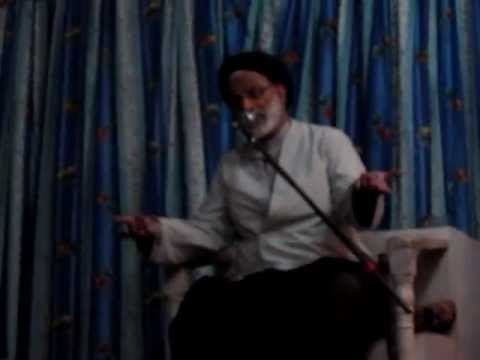Known for Qazi, scholar | Name Qazi Mohammad | |
 | ||
Residence Sakras, Ferozepur Jhirka | ||
Qazi Syed Mohammad Rafi (died 18 Rabi' al-awwal 1218 AH / 1803 AD) was a famous, religious scholar from Mewat during British India. He had influence in every sphere of life in the nearby areas of Mewat. He authored many books on religious issues.
Contents
Biography
Qazi Syed (Saiyid) Mohammad Rafi(قاضی سید محمد رفیع) was one of the outstanding men from the region of Mewat; who flourished in the era of 18th century. He was a aalim(عالم), faqih(فقیھہ) and well versed in sharia law like his father, Qazi Syed Mohammad Zaman. Being qadi of the city, he was supposed to look after all the administrative and managerial affairs of the city. He gave many judgments as Islamic lawyer.
Following is a eulogy, narrated by a Persian poet on Qazi Syed Mohammad Rafi’s death:
Family
Syed Mohammad Rafi belonged to the family Gardēzī Sadaat and was married to Fazal Nisan daughter of Mohammad Saeed ibn Mohammad Hussain ibn Maulana Abul Khair of Palwal. The mother of Fazal Nisan, Mah Bibi was the daughter of Ali Asghar bin Ali Akbar bin Abdul Wasey bin Mohammad Murad Narkhi. Ali Asghar was the brother of Mian Mohammad Shoeb’s grandfather Ali Mohammad Karwari.
His brother-in-law Raham Ali was martyred along with Aulia Khan Balooch at Pargana Hansi. His another brother-in-law Fazal Ali’s son Mohammad Murad in early life also got martyrdom while combating in a war with Jauhira Singh and Zaufa Singh at Rewari.
He had two sons Qazi Syed Mohammad Ashraf and Syed Mohammad Shamsuddin and one daughter Bibi Khan Daulat. Bibi Khan Daulat was married to Mian Mohammad Yunus.
Syed Mohammad Shamsuddin was also a man of many qualities. He was employed in the army at Nagpur and was married to Sahibun Nisan daughter of Ghulam Sharfuddin ibn Mohammad Naim ibn Mohammad Taqi ibn Abdul Hadi. Ghulam Sharfuddin was martyred with Shaikh Imam Ali at Gageen District Jodhpur by the hands of Zamindars.
Syed Mohammad Shamsuddin had one son, Masihuddin (remained unmarried), and three daughters. The elder daughter Faridun Nisan was married to Ghulam Ali ibn Qazi Qutubuddin of Jhajjar. In 1829 (1240 Fasli), Ghulam Ali migrated to Nagpur from Jhajjar where his brothers were on top position. He became Kotwal but latterly left the job in 1841. In Nagpur, Choti Masjid (Masjid Ahle Hadith) was built by him.
The elder Brother of Ghulam Ali, Mohammad Saaduddin was employed at Nagpur as Faujdar during the Bhonsle Dynasty at the princely state of Nagpur. At that time, Maharaja Senasaheb Subha Chhatrapati Raghuji Bapusaheb Bhonsle III was the ruler of the princely state of Nagpur (1818–1853). He was promoted as Subahdar in 1839 (Rajab 1247 Fasli) at Raipur. For this job, he was awarded one Palki and Rs. 900 monthly. Mohammad Saaduddin was married in 1830 at Posd, District Aiwat Mahal (Maharashtra) in a family of Jagirdar, a sister of Nawab Mohsin Ali Khan and Nawab Hasan Ali Khan. He is buried at Takia Masoom Shah. The Jamia Masjid at Nagpur was built by him. He had one son Akbar Ali Khan, who was married to Badrun Nisan, daughter of Imdad Hussain bin Ashraf Hussain (Subahdar at Chhindwara). Akbar Ali Khan was hanged to death by Britishers during the revolt of 1857 and in consequence his property was also snatched. His grave is located at Tekri Sitabildi.
Another brother of Ghulam Ali, Mohammad Saladuddin was also an administrator, kotwal and a minister in the court of Maharaja Senasaheb Subha Chhatrapati Raghuji Bapusaheb Bhonsle III. Maharaja had great faith on him, all secret papers were in the custody of Mohammad Salahuddin. Like his brother, he was also married in 1830 in the same family of Jagirdar, a sister of Nawab Mohsin Ali Khan and Nawab Hasan Ali Khan. He died in 1833 (Fasli 1243) and was buried at Takya Masoom Shah.
All these three brothers Ghulam Ali, Mohammad Saaduddin and Mohammad Saladuddin are remembered as great scholars of Urdu and Persian. They founded 'Jhajjar Bagh' at Hansapuri (Now Mominpura) at Nagpur. In this location, they built their residence 'Aina-e Mahal', a well and Masjid.
The second daughter of Syed Mohammad Shamsuddin, Fahimun Nisan was married to Mian Kalimullah Shah ibn Shah Mohammad Yahya ibn Hazrat Shah Mohammad Shoeb.
The third daughter of Syed Mohammad Shamsuddin, Masihun Nisan was married to Mufti Yaqinuddin ibn Imamuddin ibn Qutubuddin ibn Sirajul Haq. Mufti Yaqinuddin was a renowned scholar and Mufti of Rewari. Being Mufti of the city, he issued Fatwa against the British forces and to support the forces of Rao Tula Ram. In consequent to his Fatwa, Muslims of Rewari and nearby villages fought against British invasion and supported with heart and soul the small force of Rao Tula Ram. Many got martyrdom in the fight so called the 'Fight at Narnaul'. After the defeat of Rao Tula Ram on 16 November 1857, Mufti Yaqinuddin was arrested from Tijara along with brother-in-law Abdur Rahman (alias Nabi Baksh). His brother Mufti Nizamuddin was arrested from Rewari. They were taken to Delhi and hanged to death.
